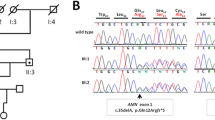Summary
In the course of a paternity investigation an apparent mother-child incompatibility was observed in the Gc system. An extensive family study was undertaken to test the hypothesis of a silent gene or null allele responsible for the contrary phenotypes: the mother had the type Gc2, the son was Gc1. The apparent incompatibility was due to a “pseudo” silent allele, called Gc*1 Θ, which controlled a group-specific component with extremely reduced serum concentrations. This double-band mutant could be differentiated from the Gc 1S bands by two-dimensional electrophoresis: isoelectric focusing (IEF)/6M urea IEF. The allele Gc*1 Θ was found in 12 persons from this family; it was not associated with any apparent disease state. Also present in this family was the variant Gc1C1. Pedigree analysis revealed a possible (not significant) distorted segregation ratio for the allele Gc*1C1, which was found in 22 of 33 offspring from marriages with one parent heterozygous for Gc*1C1.
Similar content being viewed by others
References
Brinkmann B, Söder R, Janssen W (1981) Ein weiteres Beispiel für Gc*0. In: Hummel K, Gerchow J (eds) Biomathematical evidence of paternity. Springer, Berlin Heidelberg New York, pp 127–130
Carrel RW, Jepsson JO, Laurell CB, Brennan SO, Owen MC, Vaughan L, Boswell DR (1982) Structure and variation of human 107-1. Nature 298:329–334
Cleve H, Patutschnick W, Nevo S, Wendt GG (1978) genetic studies on the Gc subtypes. Hum Genet 44:117–122
Cleve H, Patutschnick W (1979) Neuraminidase treatment reveals sialic acid differences in certain genetic variants of the Gc system (vitamin D binding protein). Hum Genet 47:193–198
Cleve H, Constans J, Berg S, Hoste B, Ishimoto G, Matsumoto H, Spees EK, Weber W (1981) Gc revisited: six further Gc-phenotypes delineated by isoelectric focusing and by polyacrylamide gel electrophoresis. Hum Genet 57:312–316
Constans J, Viau M (1977) Group-specific component: evidence for two subtypes of the Gc 1 gene. Science 198:1070–1071
Constans J, Cleve H, Viau M, Gouaillard C (1978a) Gc T (Toulouse): a fast variant of the group specific component system in a Pyrenean family. Vox Sang 34:46–50
Constans J, Viau M, Cleve H, Jaeger G, Quilici JC, Pallison MJ (1978b) Analysis of the Gc polymorphism in human populations by isoelectrofocusing on polyacrylamide gels. Demonstration of subtypes of the Gc 1 allele and of additional Gc variants. Hum Genet 41:53–60
Constans J, Cleve H, Bennet A, Bouillon R, Cox DW, Daiger SP, Ehnholm C, Fujiki N, Johnson AM, Kirk RL, Kühnl P, Martin W, Matsumoto H, Mayr WR, Miyake K, Miyazaki T, Omoto K, Porck HJ, Seger P, Thymann M, Tills D, Toyomasu M, van Baelen H, Vavrusa B, Viau M (1979) Group-specific component: Report on the first International Workshop. Hum Genet 48:143–149
Constans J, Viau M, Gouaillard C, Bouissou C, Clerc A (1980a) Binding affinities between VDBP and vitamin D3, 25-(OH)-D3, 24,25-(OH)2-D3 and 1,25-(OH)2-D3 studied by electrophoretic methods (PAGE-IEF, combined IEF-Electrophoresis) and printimmunofixation. In: Radola BJ (ed) Electrophoresis '79. Walter de Gruyter, Berlin, pp 701–709
Constans J, Viau M, Bouissou C (1980b) Affinity differences for the 25-OH-D3 associated with the genetic heterogeneity of the vitamin D-binding protein. FEBS Letters 111:107–111
Constans J (1981) La protéine serique de transport de la vitamine D chez l'homme. Son polymorphisme, ses activités metaboliques. These, Université Paul-Sabatier de Toulouse, France
Daiger SP, Schanfield MS, Cavalli-Sforza LL (1975) Group-specific component (Gc) proteins bind vitamin D and 25-Hydroxy-vitamin D. Proc Natl Acad Sci (USA) 72:2076–2080
Dykes DD, Copouls B, Polesky H (1983) Description of six new variants at the Gc locus. Hum Genet 63:35–37
Henningsen K (1966) A silent allele within the Gc-system. 4th Int Meeting Forensic Medicine, Copenhagen
Henningsen K, Jacobsen P, Mikkelsen M (1969) B-F chromosome translocation associated with father-child incompatibility within the Gc-system. Hum Hered 19:283–287
Hirschfeld J (1959) Immuno-electrophoretic demonstration of qualitative differences in human sera and their relation to the haptoglobins. Acta Path Microbiol Scand 47:160–168
Hirschfeld J (1960) Immunoelectrophoresis-procedure and application to the study of group-specific variations in sera. Science Tools 7:18–25
Johnson AM, Cleve H, Alper C (1975) Variants of the group-specific component system as demonstrated by immunofixation electrophoresis. Report of a new variant, Gc Boston (GcB). Am J Hum Genet 27:728–736
Kitchin FD (1965) Demonstration of the inherited serum group-specific protein by acrylamide electrophoresis. Proc Soc Exp Biol Med 118:304–307
Laurell C-B (1965) Antigen-antibody crossed electrophoresis. Anal Biochem 10:358–361
Laurell C-B (1967) Quantitative estimation of proteins by electrophoresis in antibody-containing agarose gel. In: Peeters H (ed) Protides of the biological fluids. Elsevier Publ Co, Amsterdam 14: 499–502
Mancini M, Carbonara AO, Heremans JF (1965) Immunochemical quantitation of antigens by single radial immunodiffusion. Immunochemist 2:235–254
Mikkelsen M, Jacobsen P, Henningsen K (1977) Possible localization of Gc-system on chromosome 4. Loss of long arm 4 material associated with father-child incompatibility within the Gc-system. Hum Hered 27:105–107
Moorhead PS, Nowell PC, Mellman WC, Battips DM, Hungerford DA (1960) Chromosome preparations of leukocytes cultured from peripheral blood. Exp Cell Res 20:613–616
Patscheider H, Dirnhofer R (1979) Scheinbar entgegengesetzte Homozygotie der Gc und EsD-Merkmale in drei Generationen. Z Rechtsmed 82:243–249
Prokop O, Rackwitz A (1968) Beweis für die Existenz eines “neuen” Gc-Gens, aufgedeckt durch eine anscheinend inkompatible Mutter-Kind-Paarung: Mutter Gc1-1, Kind Gc2-2. Deutsch Z f Gerichtl Med 62:261–268
Ritchie RF, Smith R (1976) Immunofixation I: General principle and application to agarose gel electrophoresis. Clin Chem 22:497–499
Salaman MR, Williamson AR (1971) Isoelectric focusing of proteins in the native and denatured states. Biochem J 122:93–99
Thymann M, Hjalmarsson K, Svensson M (1982) Five new Gc variants detected by isoelectrofocusing in agarose gel. Hum Genet 60:340–343
Walther JU, Stengel-Rutkowski S, Murken J-D (1974) Observations with G banding on human chromosomes. Humangenetik 25:49–51
Author information
Authors and Affiliations
Rights and permissions
About this article
Cite this article
Vavrusa, B., Cleve, H. & Constans, J. A deficiency mutant of the Gc system. Hum Genet 65, 102–107 (1983). https://doi.org/10.1007/BF00286643
Received:
Issue Date:
DOI: https://doi.org/10.1007/BF00286643




